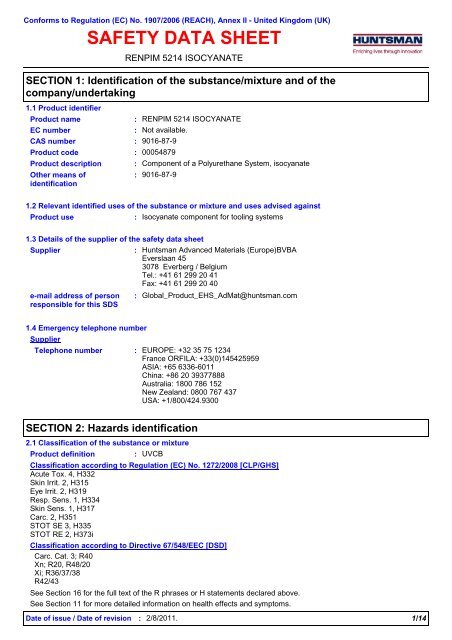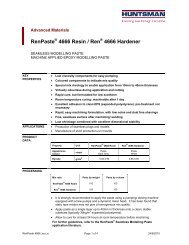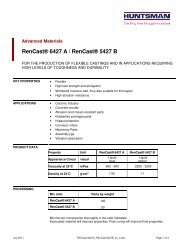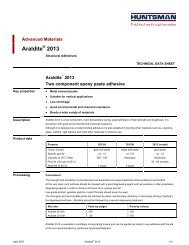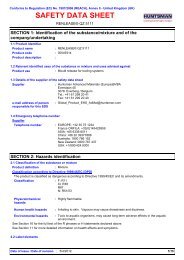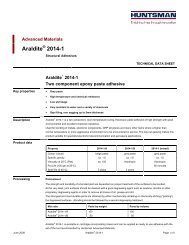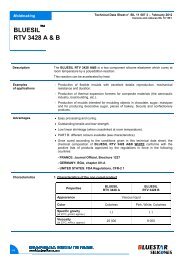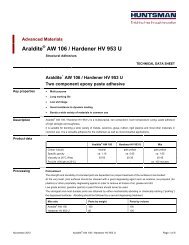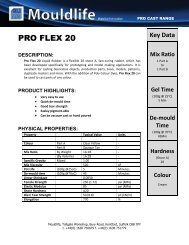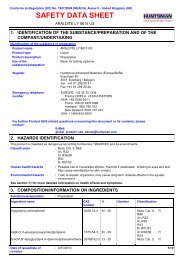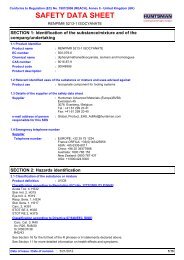View MSDS ISO - Mouldlife
View MSDS ISO - Mouldlife
View MSDS ISO - Mouldlife
You also want an ePaper? Increase the reach of your titles
YUMPU automatically turns print PDFs into web optimized ePapers that Google loves.
Conforms to Regulation (EC) No. 1907/2006 (REACH), Annex II - United Kingdom (UK)<br />
SAFETY DATA SHEET<br />
RENPIM 5214 <strong>ISO</strong>CYANATE<br />
SECTION 1: Identification of the substance/mixture and of the<br />
company/undertaking<br />
1.1 Product identifier<br />
Product name<br />
: RENPIM 5214 <strong>ISO</strong>CYANATE<br />
EC number<br />
: Not available.<br />
CAS number : 9016-87-9<br />
Product code : 00054879<br />
Product description<br />
Other means of<br />
identification<br />
: Component of a Polyurethane System, isocyanate<br />
: 9016-87-9<br />
1.2 Relevant identified uses of the substance or mixture and uses advised against<br />
Product use : Isocyanate component for tooling systems<br />
1.3 Details of the supplier of the safety data sheet<br />
Supplier<br />
e-mail address of person<br />
responsible for this SDS<br />
: Huntsman Advanced Materials (Europe)BVBA<br />
Everslaan 45<br />
3078 Everberg / Belgium<br />
Tel.: +41 61 299 20 41<br />
Fax: +41 61 299 20 40<br />
: Global_Product_EHS_AdMat@huntsman.com<br />
1.4 Emergency telephone number<br />
Supplier<br />
Telephone number : EUROPE: +32 35 75 1234<br />
France ORFILA: +33(0)145425959<br />
ASIA: +65 6336-6011<br />
China: +86 20 39377888<br />
Australia: 1800 786 152<br />
New Zealand: 0800 767 437<br />
USA: +1/800/424.9300<br />
SECTION 2: Hazards identification<br />
2.1 Classification of the substance or mixture<br />
Product definition : UVCB<br />
Classification according to Regulation (EC) No. 1272/2008 [CLP/GHS]<br />
Acute Tox. 4, H332<br />
Skin Irrit. 2, H315<br />
Eye Irrit. 2, H319<br />
Resp. Sens. 1, H334<br />
Skin Sens. 1, H317<br />
Carc. 2, H351<br />
STOT SE 3, H335<br />
STOT RE 2, H373i<br />
Classification according to Directive 67/548/EEC [DSD]<br />
Carc. Cat. 3; R40<br />
Xn; R20, R48/20<br />
Xi; R36/37/38<br />
R42/43<br />
See Section 16 for the full text of the R phrases or H statements declared above.<br />
See Section 11 for more detailed information on health effects and symptoms.<br />
Date of issue / Date of revision : 2/8/2011.<br />
1/14
Conforms to Regulation (EC) No. 1907/2006 (REACH), Annex II - United Kingdom (UK)<br />
RENPIM 5214 <strong>ISO</strong>CYANATE<br />
Date of printing : 10 February 2011 <strong>MSDS</strong> no.<br />
: 00054879<br />
Date of issue : 8 February 2011<br />
Version : 1.01<br />
2/14<br />
SECTION 2: Hazards identification<br />
2.2 Label elements<br />
Hazard pictograms :<br />
Signal word :<br />
Hazard statements :<br />
Precautionary statements<br />
Prevention :<br />
Response :<br />
Storage : Store locked up.<br />
Disposal : Not applicable.<br />
Supplemental label : Not applicable.<br />
elements<br />
Danger<br />
Harmful if inhaled.<br />
Causes skin irritation.<br />
Causes serious eye irritation.<br />
May cause allergy or asthma symptoms or breathing difficulties if inhaled.<br />
May cause an allergic skin reaction.<br />
Suspected of causing cancer.<br />
May cause respiratory irritation.<br />
May cause damage to organs through prolonged or repeated exposure if inhaled.<br />
Obtain special instructions before use. Wear protective gloves: >8 hours<br />
(breakthrough time): Ethyl Vinyl Alcohol Laminate (EVAL), butyl rubber. Wear eye or<br />
face protection. Do not breathe vapour.<br />
IF INHALED: Remove victim to fresh air and keep at rest in a position comfortable<br />
for breathing. If experiencing respiratory symptoms: Call a PO<strong>ISO</strong>N CENTER or<br />
physician.<br />
Supplemental label<br />
elements<br />
: Contains isocyanates - See information supplied by the manufacturers. This<br />
information is supplied in the current Safety Data Sheet.<br />
Special packaging requirements<br />
Containers to be fitted<br />
with child-resistant<br />
fastenings<br />
: Not applicable.<br />
Tactile warning of danger<br />
:<br />
Not applicable.<br />
2.3 Other hazards<br />
Substance meets the<br />
criteria for PBT according<br />
to Regulation (EC) No.<br />
1907/2006, Annex XIII<br />
Substance meets the<br />
criteria for vPvB according<br />
to Regulation (EC) No.<br />
1907/2006, Annex XIII<br />
Other hazards which do<br />
not result in classification<br />
: PBT: No.<br />
P: No. B: No. T: No.<br />
: vPvB: No.<br />
vP: No. vB: No.<br />
:<br />
Not available.<br />
Date of issue / Date of revision : 2/8/2011.<br />
2/14
Conforms to Regulation (EC) No. 1907/2006 (REACH), Annex II - United Kingdom (UK)<br />
RENPIM 5214 <strong>ISO</strong>CYANATE<br />
Date of printing :<br />
Date of issue :<br />
Substance/mixture<br />
Product/ingredient<br />
name<br />
:<br />
10 February 2011<br />
8 February 2011<br />
UVCB<br />
Identifiers<br />
<strong>MSDS</strong> no.<br />
SECTION 3: Composition/information on ingredients<br />
diphenylmethanediisocyanate,<br />
isomers and<br />
homologues<br />
CAS: 9016-87-9 60 -<br />
100<br />
Version :<br />
: 00054879<br />
1.01<br />
3/14<br />
% 67/548/EEC Regulation (EC) No. Type<br />
1272/2008 [CLP]<br />
Carc. Cat. 3; R40<br />
Xn; R20, R48/20<br />
Xi; R36/37/38<br />
R42/43<br />
See section 16 for<br />
the full text of the R-<br />
phrases declared<br />
above<br />
Classification<br />
Acute Tox. 4, H332<br />
Skin Irrit. 2, H315<br />
Eye Irrit. 2, H319<br />
Resp. Sens. 1, H334<br />
Skin Sens. 1, H317<br />
Carc. 2, H351<br />
STOT SE 3, H335<br />
STOT RE 2, H373i<br />
See Section 16 for the<br />
full text of the H<br />
statements declared<br />
above.<br />
[A]<br />
There are no additional ingredients present which, within the current knowledge of the supplier, are classified and<br />
contribute to the classification of the substance and hence require reporting in this section.<br />
Type<br />
[*] Substance<br />
[A] Constituent<br />
[B] Impurity<br />
[C] Stabilising additive<br />
Occupational exposure limits, if available, are listed in Section 8.<br />
SECTION 4: First aid measures<br />
4.1 Description of first aid measures<br />
Eye contact<br />
: Immediately flush eyes with plenty of water, occasionally lifting the upper and lower<br />
eyelids. Check for and remove any contact lenses. Continue to rinse for at least 10<br />
minutes. Get medical attention.<br />
Inhalation<br />
Skin contact<br />
Ingestion<br />
:<br />
:<br />
:<br />
Remove victim to fresh air and keep at rest in a position comfortable for breathing. If<br />
it is suspected that fumes are still present, the rescuer should wear an appropriate<br />
mask or self-contained breathing apparatus. If not breathing, if breathing is irregular<br />
or if respiratory arrest occurs, provide artificial respiration or oxygen by trained<br />
personnel. It may be dangerous to the person providing aid to give mouth-to-mouth<br />
resuscitation. Get medical attention. If necessary, call a poison center or physician.<br />
If unconscious, place in recovery position and get medical attention immediately.<br />
Maintain an open airway. Loosen tight clothing such as a collar, tie, belt or<br />
waistband. In the event of any complaints or symptoms, avoid further exposure.<br />
Wash with plenty of soap and water. Remove contaminated clothing and shoes.<br />
Wash contaminated clothing thoroughly with water before removing it, or wear<br />
gloves. Continue to rinse for at least 10 minutes. Get medical attention. In the<br />
event of any complaints or symptoms, avoid further exposure. Wash clothing before<br />
reuse. Clean shoes thoroughly before reuse.<br />
Wash out mouth with water. Remove dentures if any. Remove victim to fresh air<br />
and keep at rest in a position comfortable for breathing. If material has been<br />
swallowed and the exposed person is conscious, give small quantities of water to<br />
drink. Stop if the exposed person feels sick as vomiting may be dangerous. Do not<br />
induce vomiting unless directed to do so by medical personnel. If vomiting occurs,<br />
the head should be kept low so that vomit does not enter the lungs. Get medical<br />
attention. Never give anything by mouth to an unconscious person. If unconscious,<br />
place in recovery position and get medical attention immediately. Maintain an open<br />
airway. Loosen tight clothing such as a collar, tie, belt or waistband.<br />
Date of issue / Date of revision : 2/8/2011.<br />
3/14
Conforms to Regulation (EC) No. 1907/2006 (REACH), Annex II - United Kingdom (UK)<br />
RENPIM 5214 <strong>ISO</strong>CYANATE<br />
Date of printing : 10 February 2011 <strong>MSDS</strong> no.<br />
: 00054879<br />
Date of issue : 8 February 2011<br />
Version : 1.01<br />
4/14<br />
SECTION 4: First aid measures<br />
Protection of first-aiders<br />
: No action shall be taken involving any personal risk or without suitable training. If it is<br />
suspected that fumes are still present, the rescuer should wear an appropriate mask<br />
or self-contained breathing apparatus. It may be dangerous to the person providing<br />
aid to give mouth-to-mouth resuscitation. Wash contaminated clothing thoroughly<br />
with water before removing it, or wear gloves.<br />
4.2 Most important symptoms and effects, both acute and delayed<br />
Potential acute health effects<br />
Eye contact<br />
Inhalation<br />
Skin contact<br />
Ingestion<br />
:<br />
Causes serious eye irritation.<br />
: Harmful if inhaled. May cause respiratory irritation. May cause allergy or asthma<br />
symptoms or breathing difficulties if inhaled.<br />
: Causes skin irritation. May cause an allergic skin reaction.<br />
: Irritating to mouth, throat and stomach.<br />
Over-exposure signs/symptoms<br />
Eye contact<br />
: Adverse symptoms may include the following:<br />
pain or irritation<br />
watering<br />
redness<br />
Inhalation<br />
Skin contact<br />
Ingestion<br />
:<br />
:<br />
:<br />
Adverse symptoms may include the following:<br />
respiratory tract irritation<br />
coughing<br />
wheezing and breathing difficulties<br />
asthma<br />
Adverse symptoms may include the following:<br />
irritation<br />
redness<br />
No specific data.<br />
4.3 Indication of any immediate medical attention and special treatment needed<br />
Notes to physician : Treat symptomatically. Contact poison treatment specialist immediately if large<br />
quantities have been ingested or inhaled.<br />
Specific treatments : Symptomatic treatment and supportive therapy as indicated. Following severe<br />
exposure the patient should be kept under medical review for at least 48 hours.<br />
SECTION 5: Firefighting measures<br />
5.1 Extinguishing media<br />
Suitable extinguishing<br />
media<br />
Unsuitable extinguishing<br />
media<br />
:<br />
:<br />
Use an extinguishing agent suitable for the surrounding fire.<br />
None known.<br />
5.2 Special hazards arising from the substance or mixture<br />
Hazards from the<br />
substance or mixture<br />
: In a fire or if heated, a pressure increase will occur and the container may burst.<br />
Hazardous thermal<br />
decomposition products<br />
:<br />
No specific data.<br />
5.3 Advice for firefighters<br />
Special precautions for<br />
fire-fighters<br />
:<br />
Promptly isolate the scene by removing all persons from the vicinity of the incident if<br />
there is a fire. No action shall be taken involving any personal risk or without suitable<br />
training.<br />
Date of issue / Date of revision : 2/8/2011.<br />
4/14
Conforms to Regulation (EC) No. 1907/2006 (REACH), Annex II - United Kingdom (UK)<br />
RENPIM 5214 <strong>ISO</strong>CYANATE<br />
Date of printing : 10 February 2011 <strong>MSDS</strong> no.<br />
: 00054879<br />
Date of issue : 8 February 2011<br />
Version : 1.01<br />
5/14<br />
SECTION 5: Firefighting measures<br />
Special protective<br />
equipment for fire-fighters<br />
:<br />
Fire-fighters should wear appropriate protective equipment and self-contained<br />
breathing apparatus (SCBA) with a full face-piece operated in positive pressure<br />
mode. Clothing for fire-fighters (including helmets, protective boots and gloves)<br />
conforming to European standard EN 469 will provide a basic level of protection for<br />
chemical incidents.<br />
SECTION 6: Accidental release measures<br />
6.1 Personal precautions, protective equipment and emergency procedures<br />
For non-emergency<br />
personnel<br />
For emergency responders :<br />
:<br />
No action shall be taken involving any personal risk or without suitable training.<br />
Evacuate surrounding areas. Keep unnecessary and unprotected personnel from<br />
entering. Do not touch or walk through spilt material. Avoid breathing vapour or<br />
mist. Provide adequate ventilation. Wear appropriate respirator when ventilation is<br />
inadequate. Put on appropriate personal protective equipment.<br />
If specialised clothing is required to deal with the spillage, take note of any<br />
information in Section 8 on suitable and unsuitable materials. See also the<br />
information in "For non-emergency personnel".<br />
6.2 Environmental<br />
precautions<br />
:<br />
Avoid dispersal of spilt material and runoff and contact with soil, waterways, drains<br />
and sewers. Inform the relevant authorities if the product has caused environmental<br />
pollution (sewers, waterways, soil or air).<br />
6.3 Methods and materials for containment and cleaning up<br />
Small spill : Stop leak if without risk. Move containers from spill area. Dilute with water and mop<br />
up if water-soluble. Alternatively, or if water-insoluble, absorb with an inert dry<br />
material and place in an appropriate waste disposal container. Dispose of via a<br />
licensed waste disposal contractor.<br />
Large spill :<br />
Stop leak if without risk. Move containers from spill area. Approach the release<br />
from upwind. Prevent entry into sewers, water courses, basements or confined<br />
areas. Wash spillages into an effluent treatment plant or proceed as follows.<br />
Contain and collect spillage with non-combustible, absorbent material e.g. sand,<br />
earth, vermiculite or diatomaceous earth and place in container for disposal<br />
according to local regulations (see section 13). Dispose of via a licensed waste<br />
disposal contractor. Contaminated absorbent material may pose the same hazard<br />
as the spilt product. Note: see section 1 for emergency contact information and<br />
section 13 for waste disposal.<br />
6.4 Reference to other<br />
sections<br />
:<br />
See Section 1 for emergency contact information.<br />
See Section 8 for information on appropriate personal protective equipment.<br />
See Section 13 for additional waste treatment information.<br />
SECTION 7: Handling and storage<br />
The information in this section contains generic advice and guidance. The list of Identified Uses in Section 1 should be<br />
consulted for any available use-specific information provided in the Exposure Scenario(s).<br />
7.1 Precautions for safe handling<br />
Protective measures<br />
: Put on appropriate personal protective equipment (see Section 8). Persons with a<br />
history of skin sensitisation problems or asthma, allergies or chronic or recurrent<br />
respiratory disease should not be employed in any process in which this product is<br />
used. Avoid exposure - obtain special instructions before use. Do not handle until<br />
all safety precautions have been read and understood. Do not get in eyes or on skin<br />
or clothing. Do not breathe vapour or mist. Do not ingest. Use only with adequate<br />
ventilation. Wear appropriate respirator when ventilation is inadequate. Keep in the<br />
original container or an approved alternative made from a compatible material, kept<br />
tightly closed when not in use. Empty containers retain product residue and can be<br />
hazardous. Do not reuse container.<br />
Date of issue / Date of revision : 2/8/2011.<br />
5/14
Conforms to Regulation (EC) No. 1907/2006 (REACH), Annex II - United Kingdom (UK)<br />
RENPIM 5214 <strong>ISO</strong>CYANATE<br />
Date of printing : 10 February 2011 <strong>MSDS</strong> no.<br />
: 00054879<br />
Date of issue : 8 February 2011<br />
Version : 1.01<br />
6/14<br />
SECTION 7: Handling and storage<br />
Advice on general<br />
occupational hygiene<br />
:<br />
Eating, drinking and smoking should be prohibited in areas where this material is<br />
handled, stored and processed. Workers should wash hands and face before<br />
eating, drinking and smoking. Remove contaminated clothing and protective<br />
equipment before entering eating areas. See also Section 8 for additional<br />
information on hygiene measures.<br />
7.2 Conditions for safe<br />
storage, including any<br />
incompatibilities<br />
:<br />
Storage temperature: 2 to 40°C (35.6 to 104°F). Store in accordance with local<br />
regulations. Store in original container protected from direct sunlight in a dry, cool<br />
and well-ventilated area, away from incompatible materials (see section 10) and food<br />
and drink. Store locked up. Keep container tightly closed and sealed until ready for<br />
use. Containers that have been opened must be carefully resealed and kept upright<br />
to prevent leakage. Do not store in unlabelled containers. Use appropriate<br />
containment to avoid environmental contamination.<br />
Storage hazard class<br />
Huntsman Advanced<br />
Materials<br />
: Storage class 12, Liquids, not dangerous<br />
7.3 Specific end use(s)<br />
Recommendations :<br />
Industrial sector specific<br />
solutions<br />
:<br />
Not available.<br />
Not available.<br />
SECTION 8: Exposure controls/personal protection<br />
The information in this section contains generic advice and guidance. The list of Identified Uses in Section 1 should be<br />
consulted for any available use-specific information provided in the Exposure Scenario(s).<br />
8.1 Control parameters<br />
Occupational exposure limits<br />
Product/ingredient name<br />
diphenylmethanediisocyanate, isomers and<br />
homologues<br />
Exposure limit values<br />
EH40/2005 WELs (United Kingdom (UK), 8/2007). Skin<br />
sensitiser. Notes: as NCO<br />
STEL: 0.07 mg/m³, (as NCO) 15 minute(s).<br />
TWA: 0.02 mg/m³, (as NCO) 8 hour(s).<br />
Recommended monitoring<br />
procedures<br />
Derived effect levels<br />
No DELs available.<br />
:<br />
If this product contains ingredients with exposure limits, personal, workplace<br />
atmosphere or biological monitoring may be required to determine the effectiveness<br />
of the ventilation or other control measures and/or the necessity to use respiratory<br />
protective equipment. Reference should be made to European Standard EN 689 for<br />
methods for the assessment of exposure by inhalation to chemical agents and<br />
national guidance documents for methods for the determination of hazardous<br />
substances.<br />
Predicted effect concentrations<br />
No PECs available.<br />
8.2 Exposure controls<br />
Appropriate engineering<br />
controls<br />
: Use only with adequate ventilation. Use process enclosures, local exhaust<br />
ventilation or other engineering controls to keep worker exposure to airborne<br />
contaminants below any recommended or statutory limits.<br />
Date of issue / Date of revision : 2/8/2011.<br />
6/14
Conforms to Regulation (EC) No. 1907/2006 (REACH), Annex II - United Kingdom (UK)<br />
RENPIM 5214 <strong>ISO</strong>CYANATE<br />
Date of printing : 10 February 2011 <strong>MSDS</strong> no.<br />
: 00054879<br />
Date of issue : 8 February 2011<br />
Version : 1.01<br />
7/14<br />
SECTION 8: Exposure controls/personal protection<br />
Individual protection measures<br />
Hygiene measures :<br />
Eye/face protection<br />
Skin protection<br />
Hand protection<br />
Material of gloves for<br />
long term application<br />
(BTT>480min):<br />
Material of gloves for<br />
short term/splash<br />
application<br />
(10min
Conforms to Regulation (EC) No. 1907/2006 (REACH), Annex II - United Kingdom (UK)<br />
RENPIM 5214 <strong>ISO</strong>CYANATE<br />
Date of printing : 10 February 2011 <strong>MSDS</strong> no.<br />
: 00054879<br />
Date of issue : 8 February 2011<br />
Version : 1.01<br />
8/14<br />
SECTION 9: Physical and chemical properties<br />
Evaporation rate<br />
Flammability (solid, gas)<br />
:<br />
Not available.<br />
: Not available.<br />
Burning time<br />
Burning rate<br />
Upper/lower flammability or<br />
explosive limits<br />
:<br />
:<br />
:<br />
Not applicable.<br />
Not applicable.<br />
Not available.<br />
Vapour pressure<br />
Vapour density<br />
Relative density<br />
Solubility(ies)<br />
Water solubility :<br />
Other<br />
Partition coefficient: n-<br />
octanol/water<br />
:<br />
:<br />
:<br />
:<br />
:<br />
0.00001 kPa [20°C]<br />
8.5 [Air = 1]<br />
1.24<br />
20 deg C<br />
Decomposes in water.<br />
Soluble in the following materials: methanol, diethyl ether and acetone.<br />
Not available.<br />
Auto-ignition temperature : >600°C<br />
Decomposition temperature : >250°C<br />
Viscosity<br />
: Dynamic: 250 mPa·s<br />
Explosive properties<br />
: Not available.<br />
Oxidising properties : None<br />
25 deg C<br />
9.2 Other information<br />
Density<br />
: 1.2 g/cm 3 [25°C (77°F)]<br />
SECTION 10: Stability and reactivity<br />
10.1 Reactivity : No specific test data related to reactivity available for this product or its ingredients.<br />
10.2 Chemical stability<br />
:<br />
The product is stable.<br />
10.3 Possibility of<br />
hazardous reactions<br />
: Under normal conditions of storage and use, hazardous reactions will not occur.<br />
10.4 Conditions to avoid : No specific data.<br />
10.5 Incompatible materials :<br />
No specific data.<br />
strong acids, strong bases, strong oxidising agents<br />
10.6 Hazardous<br />
decomposition products<br />
:<br />
Under normal conditions of storage and use, hazardous decomposition products<br />
should not be produced.<br />
Date of issue / Date of revision : 2/8/2011.<br />
8/14
Conforms to Regulation (EC) No. 1907/2006 (REACH), Annex II - United Kingdom (UK)<br />
RENPIM 5214 <strong>ISO</strong>CYANATE<br />
Date of printing :<br />
Date of issue :<br />
10 February 2011<br />
8 February 2011<br />
SECTION 11: Toxicological information<br />
11.1 Information on toxicological effects<br />
Acute toxicity<br />
diphenylmethanediisocyanate,<br />
isomers and homologues<br />
<strong>MSDS</strong> no.<br />
Version :<br />
: 00054879<br />
Product/ingredient name Endpoint Species Result Exposure<br />
Irritation/Corrosion<br />
Conclusion/Summary<br />
Sensitiser<br />
Conclusion/Summary<br />
Mutagenicity<br />
Conclusion/Summary<br />
Carcinogenicity<br />
Product/ingredient<br />
name<br />
diphenylmethanediisocyanate,<br />
isomers and<br />
homologues<br />
1.01<br />
LD50 Oral Rat >2000 mg/kg -<br />
Product/ingredient name Test Result<br />
diphenylmethanediisocyanate,<br />
isomers and homologues<br />
Reproductive toxicity<br />
Teratogenicity<br />
diphenylmethanediisocyanate,<br />
isomers and homologues<br />
OECD 474<br />
Test Species Exposure Result<br />
OECD 453 Combined Chronic<br />
Toxicity/Carcinogenicity<br />
Studies<br />
Negative<br />
- Equivocal<br />
: Not available.<br />
Rat 2 years; 5<br />
days per<br />
week<br />
EU Rat 2 years; 5<br />
days per<br />
week<br />
OECD 414 Prenatal Developmental<br />
Toxicity Study<br />
Rat - Male,<br />
Female<br />
Negative Inhalation -<br />
Negative Inhalation -<br />
Product/ingredient name Test Species Result/Result type Target<br />
organs<br />
diphenylmethanediisocyanate,<br />
isomers and homologues<br />
: Not available.<br />
Product/ingredient name Test Route of<br />
exposure<br />
diphenylmethanediisocyanate,<br />
isomers and homologues<br />
- skin Guinea pig Sensitising<br />
: Not available.<br />
OECD 414 Prenatal Developmental<br />
Toxicity Study<br />
Rat Inhalation: NOAEL -<br />
Product/ingredient name Test Species Result/Result type<br />
Specific target organ toxicity (single exposure)<br />
Specific target organ toxicity (repeated exposure)<br />
Aspiration hazard<br />
Product/ingredient name<br />
Product/ingredient name<br />
Category<br />
Category<br />
Species<br />
4 mg/m3 NOAEL<br />
Route of<br />
exposure<br />
Route of<br />
exposure<br />
Route of<br />
exposure<br />
Result<br />
Target organs<br />
diphenylmethanediisocyanate, isomers and homologues Category 3 Not determined Respiratory tract<br />
irritation<br />
Target organs<br />
diphenylmethanediisocyanate, isomers and homologues Category 2 Inhalation Not determined<br />
9/14<br />
Target<br />
organs<br />
Date of issue / Date of revision : 2/8/2011.<br />
9/14
Conforms to Regulation (EC) No. 1907/2006 (REACH), Annex II - United Kingdom (UK)<br />
RENPIM 5214 <strong>ISO</strong>CYANATE<br />
Date of printing : 10 February 2011 <strong>MSDS</strong> no.<br />
: 00054879<br />
Date of issue : 8 February 2011<br />
Version : 1.01<br />
SECTION 11: Toxicological information<br />
Not available.<br />
10/14<br />
Information on the likely<br />
routes of exposure<br />
Potential acute health effects<br />
Inhalation<br />
: Harmful if inhaled. May cause respiratory irritation. May cause allergy or asthma<br />
symptoms or breathing difficulties if inhaled.<br />
Ingestion<br />
Skin contact<br />
Eye contact<br />
Potential chronic health effects<br />
diphenylmethanediisocyanate,<br />
isomers and homologues<br />
:<br />
Irritating to mouth, throat and stomach.<br />
: Causes skin irritation. May cause an allergic skin reaction.<br />
: Causes serious eye irritation.<br />
Symptoms related to the physical, chemical and toxicological characteristics<br />
Inhalation<br />
: Adverse symptoms may include the following:<br />
respiratory tract irritation<br />
coughing<br />
wheezing and breathing difficulties<br />
asthma<br />
Ingestion<br />
Skin contact<br />
Eye contact<br />
Product/ingredient name Test Result type Result<br />
Conclusion/Summary : Not available.<br />
General : May cause damage to organs through prolonged or repeated exposure if inhaled.<br />
Once sensitized, a severe allergic reaction may occur when subsequently exposed<br />
to very low levels.<br />
Carcinogenicity :<br />
Mutagenicity :<br />
Teratogenicity :<br />
Developmental effects<br />
:<br />
:<br />
:<br />
Not available.<br />
No specific data.<br />
Adverse symptoms may include the following:<br />
irritation<br />
redness<br />
: Adverse symptoms may include the following:<br />
pain or irritation<br />
watering<br />
redness<br />
Delayed and immediate effects and also chronic effects from short and long term exposure<br />
Short term exposure<br />
Potential immediate<br />
effects<br />
Potential delayed effects :<br />
Long term exposure<br />
Potential immediate<br />
effects<br />
Potential delayed effects :<br />
:<br />
:<br />
Not available.<br />
Not available.<br />
Not available.<br />
Not available.<br />
OECD 453 Combined Chronic<br />
Toxicity/Carcinogenicity<br />
Studies<br />
OECD 412 Repeated Dose<br />
Inhalation Toxicity: 28-day or<br />
14-day Study<br />
NOEC<br />
LOEC<br />
Dusts and<br />
mists<br />
Dusts and<br />
mists<br />
Suspected of causing cancer. Risk of cancer depends on duration and level of<br />
exposure.<br />
No known significant effects or critical hazards.<br />
No known significant effects or critical hazards.<br />
: No known significant effects or critical hazards.<br />
Fertility effects<br />
: No known significant effects or critical hazards.<br />
Other information : Not available.<br />
0.2 mg/m3 -<br />
1.1 mg/m3 -<br />
Target organs<br />
Date of issue / Date of revision : 2/8/2011.<br />
10/14
Conforms to Regulation (EC) No. 1907/2006 (REACH), Annex II - United Kingdom (UK)<br />
RENPIM 5214 <strong>ISO</strong>CYANATE<br />
Date of printing : 10 February 2011 <strong>MSDS</strong> no.<br />
: 00054879<br />
Date of issue : 8 February 2011<br />
Version : 1.01<br />
11/14<br />
SECTION 12: Ecological information<br />
12.1 Toxicity<br />
Product/ingredient name Test<br />
Endpoint Exposure Species Result<br />
diphenylmethanediisocyanate,<br />
isomers and homologues<br />
- Acute EC50 24 hours Daphnia >1000 mg/L<br />
- Acute LC50 96 hours Fish >1000 mg/L<br />
12.2 Persistence and degradability<br />
Product/ingredient name Aquatic half-life Photolysis Biodegradability<br />
diphenylmethanediisocyanate,<br />
isomers and homologues<br />
Fresh water 0.8 days - -<br />
12.3 Bioaccumulative potential<br />
Product/ingredient name<br />
diphenylmethanediisocyanate,<br />
isomers and homologues<br />
LogPow BCF Potential<br />
- 200 high<br />
12.4 Mobility in soil<br />
Soil/water partition<br />
coefficient (KOC)<br />
Mobility<br />
:<br />
:<br />
Not available.<br />
Not available.<br />
12.5 Results of PBT and vPvB assessment<br />
PBT<br />
vPvB<br />
: PBT: No.<br />
P: No. B: No. T: No.<br />
: vPvB: No.<br />
vP: No. vB: No.<br />
12.6 Other adverse effects : No known significant effects or critical hazards.<br />
12.7 Other ecological information<br />
SECTION 13: Disposal considerations<br />
The information in this section contains generic advice and guidance. The list of Identified Uses in Section 1 should be<br />
consulted for any available use-specific information provided in the Exposure Scenario(s).<br />
13.1 Waste treatment methods<br />
Product<br />
Methods of disposal<br />
Hazardous waste : Yes.<br />
European waste catalogue (EWC)<br />
Packaging<br />
Waste code<br />
:<br />
The generation of waste should be avoided or minimised wherever possible.<br />
Significant quantities of waste product residues should not be disposed of via the<br />
foul sewer but processed in a suitable effluent treatment plant. Dispose of surplus<br />
and non-recyclable products via a licensed waste disposal contractor. Disposal of<br />
this product, solutions and any by-products should at all times comply with the<br />
requirements of environmental protection and waste disposal legislation and any<br />
regional local authority requirements.<br />
07 02 08* other still bottoms and reaction residues<br />
Waste designation<br />
Date of issue / Date of revision : 2/8/2011.<br />
11/14
Conforms to Regulation (EC) No. 1907/2006 (REACH), Annex II - United Kingdom (UK)<br />
RENPIM 5214 <strong>ISO</strong>CYANATE<br />
Date of printing : 10 February 2011 <strong>MSDS</strong> no.<br />
: 00054879<br />
Date of issue : 8 February 2011<br />
Version : 1.01<br />
12/14<br />
SECTION 13: Disposal considerations<br />
Methods of disposal :<br />
Special precautions :<br />
The generation of waste should be avoided or minimised wherever possible. Waste<br />
packaging should be recycled. Incineration or landfill should only be considered<br />
when recycling is not feasible.<br />
This material and its container must be disposed of in a safe way. Care should be<br />
taken when handling emptied containers that have not been cleaned or rinsed out.<br />
Empty containers or liners may retain some product residues. Avoid dispersal of<br />
spilt material and runoff and contact with soil, waterways, drains and sewers.<br />
SECTION 14: Transport information<br />
14.1 UN number 14.2 UN proper shipping name<br />
ADR/RID Not regulated.<br />
ADN/ADNRNot available.<br />
IMDG Not regulated.<br />
IATA Not regulated.<br />
-<br />
Not available.<br />
-<br />
-<br />
ADR/RID ADN/ADNR<br />
IMDG IATA<br />
14.3 Transport<br />
hazard class(es)<br />
-<br />
Not available.<br />
-<br />
-<br />
14.4 Packing<br />
group<br />
-<br />
-<br />
-<br />
-<br />
14.5<br />
Environmental<br />
hazards<br />
14.6 Special<br />
precautions for<br />
user<br />
No. No. No. No.<br />
Not available. Not available. Not available. Not available.<br />
Additional<br />
information<br />
- - Emergency<br />
schedules (EmS)<br />
-<br />
14.7 Transport in bulk<br />
according to Annex II of<br />
MARPOL 73/78 and the IBC<br />
Code<br />
: Not applicable.<br />
SECTION 15: Regulatory information<br />
15.1 Safety, health and environmental regulations/legislation specific for the substance or mixture<br />
EU Regulation (EC) No. 1907/2006 (REACH)<br />
Annex XIV - List of substances subject to authorisation<br />
Substances of very high concern<br />
None of the components are listed.<br />
Annex XVII - Restrictions<br />
on the manufacture,<br />
placing on the market and<br />
use of certain dangerous<br />
substances, mixtures and<br />
articles<br />
:<br />
Not applicable.<br />
Other EU regulations<br />
Europe inventory<br />
: This material is listed or exempted.<br />
Date of issue / Date of revision : 2/8/2011.<br />
12/14
Conforms to Regulation (EC) No. 1907/2006 (REACH), Annex II - United Kingdom (UK)<br />
RENPIM 5214 <strong>ISO</strong>CYANATE<br />
Date of printing :<br />
Date of issue :<br />
10 February 2011<br />
8 February 2011<br />
SECTION 15: Regulatory information<br />
Black List Chemicals<br />
Priority List Chemicals<br />
Integrated pollution<br />
prevention and control<br />
list (IPPC) - Air<br />
Integrated pollution<br />
prevention and control<br />
list (IPPC) - Water<br />
: Not listed<br />
: Not listed<br />
: Not listed<br />
: Not listed<br />
<strong>MSDS</strong> no.<br />
Version :<br />
: 00054879<br />
1.01<br />
13/14<br />
Product/ingredient name<br />
diphenylmethanediisocyanate,<br />
isomers and homologues<br />
National regulations<br />
References<br />
International regulations<br />
Chemical Weapons<br />
Convention List Schedule I<br />
Chemicals<br />
Carcinogenic<br />
effects<br />
: The provision of Safety Data Sheets comes under Regulation 6 of CHIP (CHIP is the<br />
recognised abbreviation for the Chemicals Hazard Information and Packaging<br />
Regulations). This is an addition to the Health and Safety at Work Act 1974.<br />
: Not listed<br />
Mutagenic effects<br />
Developmental<br />
effects<br />
Carc. 2, H351 - - -<br />
Fertility effects<br />
Chemical Weapons<br />
Convention List Schedule II<br />
Chemicals<br />
Chemical Weapons<br />
Convention List Schedule III<br />
Chemicals<br />
: Not listed<br />
: Not listed<br />
15.2 Chemical Safety<br />
Assessment<br />
:<br />
Not available.<br />
SECTION 16: Other information<br />
Indicates information that has changed from previously issued version.<br />
Abbreviations and<br />
acronyms<br />
: ATE = Acute Toxicity Estimate<br />
CLP = Classification, Labelling and Packaging Regulation [Regulation (EC) No.<br />
1272/2008]<br />
DNEL = Derived No Effect Level<br />
EUH statement = CLP-specific Hazard statement<br />
PNEC = Predicted No Effect Concentration<br />
RRN = REACH Registration Number<br />
Procedure used to derive the classification according to Regulation (EC) No. 1272/2008 [CLP/GHS]<br />
Acute Tox. 4, H332<br />
Skin Irrit. 2, H315<br />
Eye Irrit. 2, H319<br />
Resp. Sens. 1, H334<br />
Skin Sens. 1, H317<br />
Carc. 2, H351<br />
STOT SE 3, H335<br />
STOT RE 2, H373i<br />
Classification<br />
Expert judgment<br />
Expert judgment<br />
Expert judgment<br />
Expert judgment<br />
Expert judgment<br />
Expert judgment<br />
Expert judgment<br />
Expert judgment<br />
Justification<br />
Date of issue / Date of revision : 2/8/2011.<br />
13/14
Conforms to Regulation (EC) No. 1907/2006 (REACH), Annex II - United Kingdom (UK)<br />
RENPIM 5214 <strong>ISO</strong>CYANATE<br />
Date of printing :<br />
Date of issue :<br />
10 February 2011<br />
8 February 2011<br />
SECTION 16: Other information<br />
Full text of abbreviated H<br />
statements<br />
Full text of classifications<br />
[CLP/GHS]<br />
Full text of abbreviated R<br />
phrases<br />
Full text of classifications<br />
[DSD/DPD]<br />
Date of printing<br />
Date of issue/ Date of<br />
revision<br />
Date of previous issue<br />
Version<br />
Notice to reader<br />
:<br />
:<br />
:<br />
:<br />
:<br />
:<br />
:<br />
:<br />
H315<br />
H317<br />
H319<br />
H332<br />
H334<br />
H335<br />
H351<br />
H373i<br />
<strong>MSDS</strong> no. : 00054879<br />
2/10/2011.<br />
<strong>MSDS</strong> no.<br />
Carc. Cat. 3 - Carcinogen category 3<br />
Xn - Harmful<br />
Xi - Irritant<br />
2/8/2011.<br />
No previous validation.<br />
1.01<br />
Version :<br />
: 00054879<br />
1.01<br />
14/14<br />
Causes skin irritation.<br />
May cause an allergic skin reaction.<br />
Causes serious eye irritation.<br />
Harmful if inhaled.<br />
May cause allergy or asthma symptoms or breathing difficulties if inhaled.<br />
May cause respiratory irritation.<br />
Suspected of causing cancer.<br />
May cause damage to organs through prolonged or repeated exposure if<br />
inhaled.<br />
Acute Tox. 4, H332 ACUTE TOXICITY: INHALATION - Category 4<br />
Carc. 2, H351 CARCINOGENICITY - Category 2<br />
Eye Irrit. 2, H319 SERIOUS EYE DAMAGE/ EYE IRRITATION - Category 2<br />
Resp. Sens. 1, H334 RESPIRATORY SENSITIZATION - Category 1<br />
Skin Irrit. 2, H315 SKIN CORROSION/IRRITATION - Category 2<br />
Skin Sens. 1, H317 SKIN SENSITIZATION - Category 1<br />
STOT RE 2, H373i SPECIFIC TARGET ORGAN TOXICITY (REPEATED<br />
EXPOSURE): INHALATION - Category 2<br />
STOT SE 3, H335 SPECIFIC TARGET ORGAN TOXICITY (SINGLE<br />
EXPOSURE) [Respiratory tract irritation] - Category 3<br />
R40- Limited evidence of a carcinogenic effect.<br />
R20- Harmful by inhalation.<br />
R48/20- Harmful: danger of serious damage to health by prolonged exposure<br />
through inhalation.<br />
R36/37/38- Irritating to eyes, respiratory system and skin.<br />
R42/43- May cause sensitisation by inhalation and skin contact.<br />
While the information and recommendations in this publication are to the best of our knowledge, information<br />
and belief accurate at the date of publication, NOTHING HEREIN IS TO BE CONSTRUED AS A WARRANTY,<br />
EXPRESS OR OTHERWISE.<br />
IN ALL CASES, IT IS THE RESPONSIBILITY OF THE USER TO DETERMINE THE APPLICABILITY OF SUCH<br />
INFORMATION AND RECOMMENDATIONS AND THE SUITABILITY OF ANY PRODUCT FOR ITS OWN<br />
PARTICULAR PURPOSE.<br />
THE PRODUCT MAY PRESENT HAZARDS AND SHOULD BE USED WITH CAUTION. WHILE CERTAIN HAZARDS<br />
ARE DESCRIBED IN THIS PUBLICATION, NO GUARANTEE IS MADE THAT THESE ARE THE ONLY HAZARDS<br />
THAT EXIST.<br />
Hazards, toxicity and behaviour of the products may differ when used with other materials and are dependent<br />
upon the manufacturing circumstances or other processes. Such hazards, toxicity and behaviour should be<br />
determined by the user and made known to handlers, processors and end users.<br />
NO PERSON OR ORGANIZATION EXCEPT A DULY AUTHORIZED HUNTSMAN EMPLOYEE IS AUTHORIZED TO<br />
PROVIDE OR MAKE AVAILABLE DATA SHEETS FOR HUNTSMAN PRODUCTS. DATA SHEETS FROM<br />
UNAUTHORIZED SOURCES MAY CONTAIN INFORMATION THAT IS NO LONGER CURRENT OR ACCURATE.<br />
NO PART OF THIS DATA SHEET MAY BE REPRODUCED OR TRANSMITTED IN ANY FORM, OR BY ANY<br />
MEANS, WITHOUT PERMISSION IN WRITING FROM HUNTSMAN. ALL REQUESTS FOR PERMISSION TO<br />
REPRODUCE MATERIAL FROM THIS DATA SHEET SHOULD BE DIRECTED TO HUNTSMAN, MANAGER,<br />
PRODUCT SAFETY AT THE ABOVE ADDRESS.<br />
Date of issue / Date of revision : 2/8/2011.<br />
14/14


